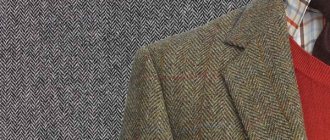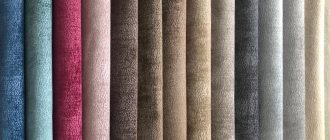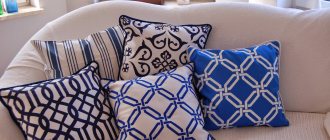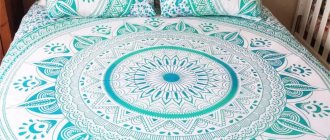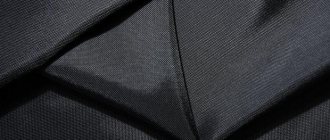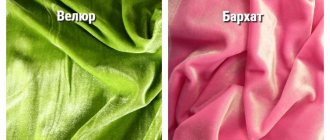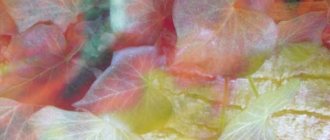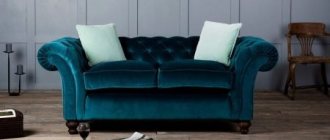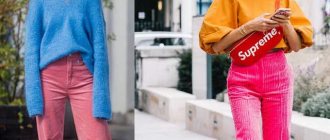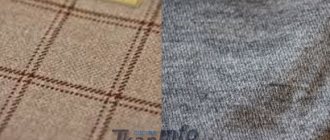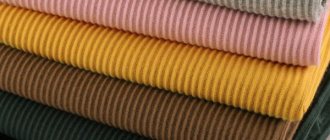Jacket material
Modern models are made from a variety of fabrics, including: natural, natural and mixed fibers. These products are made from wool, cashmere, cotton, as well as linen and matting. One of the popular models are jackets made of mixed fabrics in a combination of cotton and polyester. An interesting solution would be jackets made of worsted fabrics.
The lining matters too
A good suit must have a lining. This element protects and masks the reverse surface of the main fabric. The rigid base prevents thin woolen fabric from deforming, and the clothes keep their shape well. The smooth surface makes it easy to put the jacket on a shirt. Don’t think that no one will see the wrong side; an experienced eye will immediately notice that the inside of an expensive suit is made of low-quality cheap fabric. In addition to looking cheap, low-quality material can become stained with sweat, become deformed, or quickly become unusable.
If you are sewing an expensive formal suit, you can make the lining from silk. This material looks expensive and beautiful, but it has one drawback: stains from sweat will be immediately noticeable. The best lining fabric for a casual set is viscose. Cellulose fibers provide a comfortable microclimate; such clothes will not be hot in the summer season. If you want to surprise others with a color-changing lining, use shanzhan - a mixture of viscose and acetate silk.
If you want to save on lining, buy a linen made of acetate, polyester or polyester. Most of these fabrics are not very durable and will stain from sweat. If you are sewing a suit for the cool season, and do not intend to take off your jacket and show off its lining to everyone around you, you can use these fabrics. Cheap materials are often used for jackets, where the lining is sewn only to the back, and the fronts are made of a single layer of fabric. In this case, unless you remove the top of the set in public, no one will know what the backing is made of.
Features of choice
Among all the variety of materials, it’s easy to get confused which fabric to choose for a suit. Suit and coat fabrics make up the largest group of all woven fabrics. Products made from such materials can have a wide variety of compositions, from natural cotton to pure synthetics.
When choosing which fabric is best to make a suit from, you need to take into account the seasonality, your gender and age.
When making spring-summer clothes, white linen suiting fabric, cotton, denim, and stretch are used. For the autumn-winter season you will need thicker suiting fabric: wool, wool blend, drape. The best fabric for a men's suit is pure, 100% wool. You can choose a material of a single color or a plaid pattern. To increase the strength and wear resistance of the product, synthetic fibers are often added to the composition of the material. Look at other articles in the section: “Fabrics for different clothes”.
Advantages of jackets
These products have many advantages; thanks to the wide range, they can be found in any person’s wardrobe. Let's give an example of the main advantages of jackets:
- versatility (these models can be successfully combined with both trousers and jeans. Today you can choose almost any color of fabric for sewing jackets, so everyone can choose the most suitable option)
- high quality
- hypoallergenic (jackets do not cause any allergic reactions and do not emit unpleasant odors)
- have a luxurious appearance (the jacket is guaranteed to transform any person’s image, bringing formality and status)
- can be used both for every day and for any festive or social event
- practicality (depending on the fabric that is included in these products, care may vary; jackets made from mixed fibers do not accumulate dust and dirt and do not require any additional care efforts)
- durability (modern jackets have a long service life; if treated with care and proper care, they will last for more than a year)
- high levels of hygroscopicity and wear resistance (these models withstand various impacts with dignity, while maintaining their appearance and all the positive qualities)
- ideal for business meetings
Types of fabric for men's suits
A high-quality men's suit is made only from pure wool. Of course, you can buy inexpensive fabric with a high content of artificial fibers, but an experienced eye will immediately notice that you are wearing cheap things, and in serious negotiations you will be treated accordingly. These clothes can be used for communicating with loved ones, going to the store or to the market.
Natural wool is famous for its structure. Each hair contains a microscopic hollow tube filled with air. Such clothing allows the body to breathe and does not trap sweat. In cold weather you will be warm, and in hot weather there will be no sweat running down your back. Fibers have the ability to independently take their original shape. If the suit is wrinkled, just hang it on hangers, and after a few hours all the wrinkles will straighten out.
It is also acceptable to wear a cashmere suit. In these threads, about 8% flax fibers are added to high-quality wool.
To avoid buying bad material, do not buy it on the market, go to a specialized department that sells good fabrics. Carefully read the description of the material - it should indicate what kind of wool it is made from. High-quality fabric can only be made from the fleece of purebred sheep. Merino wool grown in Australia or New Zealand has the best characteristics. Their long fibers have the same thickness, and they are used to spin thin, strong threads without thickening.
Companies that produce canvas from natural high-quality materials are trusted:
- Scabal is a Belgian company that produces suiting fabrics from very fine wool;
- Loro Piana mainly produces fabrics for sports suits;
- Ermenegildo Zegna purchases the finest wool in Italy to make high-quality fabric for suits;
- Holland&Cherry dresses famous artists.
If you notice uneven places, pills, or thorns in the fabric, it means the material is of low quality. You can take it for everyday wear, work, walking. Good matter can be in demand in any situation. In the summer, a suit made of the finest wool will prevent you from sweating.
Good products are determined according to the English classification. Look for the word “Super” on the label. If this term is followed by the number 220, the fabric is made from the finest wool and will not keep you hot in summer. The lower the number, the thicker and warmer the suit fabric will be. If the characteristics of the fabric contain an index of 100, the material can be used to sew a suit for the cold season.
Advice
If you want to buy expensive fabric, consult a tailor and find out how much fabric you will need for your suit. Usually, with a canvas width of 1.5 m, one set takes no more than 3 m, but in order not to make a mistake with the quantity, it is better to get recommendations from a specialist.
The history of jackets
The origin of the term “jacket” is associated with the Netherlands; it was from this country that the prototype of the models that were later used to cut the jacket was brought. Initially, this clothing was very similar to a caftan, the distinctive features were the presence of 2 or 3 buttons, and their length was knee-length. These were practical and comfortable things that did not have high aesthetics, which, as a rule, were made from felt and natural fibers.
Over time, the jacket changed, and these clothes were worn by aristocrats. Around the 18th – 19th centuries, jackets became popular, and frock coats, tailcoats and other types of these products became in demand. For example, during the reign of Louis XIV they were distinguished by the fact that they were more like a cloak. On the other hand, various references to such clothing in the works of well-known and famous authors contributed to the great demand. One of the disadvantages of jackets was the inconvenience of riding a horse.
A little later, jackets became widespread among women. Fashion designer Coco Chanel had her say in gaining popularity. At first, many critics and clothing designers attacked it; many believed that this clothing neutralizes femininity, hides female forms and is considered a purely masculine element of the wardrobe. However, time passed and women's jackets were amazingly combined with trousers; they provided a strict and business-like look, symbolizing a woman's autonomy and independence.
A more modern type of jacket began to take shape only at the beginning of the 20th century; these clothes began to have standards for collar length, style and pockets; previously, only things very similar to a jacket could be observed. Currently, jackets are of great interest; a tuxedo is considered a very stylish and indispensable element in the wardrobe of any man. Today it is impossible to imagine going to a business meeting or to work without this stylish clothing. Jackets have become universal - they look luxurious and delightful with almost any style of clothing: they harmonize, for example, with classic boots, as well as sneakers and boots.
Fabric for casual suit
Pure wool is expensive and requires careful handling. Products made from high-quality fabric should “rest” - they are not recommended to be worn more than once a week. The rest of the time the suit is stored in the closet, neatly hung on special devices. The next time you put it on, all the stretching and bruising will smooth out on its own.
Some men do not recognize jeans and T-shirts; they consider trousers and a jacket to be their main clothing. For everyday use, you can purchase fabrics with the addition of synthetic fibers. Such clothes will look out of place at serious events, but your look will be suitable for working at the computer or talking with clients. In a suit made of such material you will feel comfortable, you will not worry about stretched knees and worn out elbows. When you come to the store, find out the composition and properties of the selected fabric, so that later you do not suffer in clothes that are too hot or do not allow air to pass through.
For casual men's suits, fabric consisting of 55% wool is usually used, the rest being synthetic fibers. They give clothing stability and allow the product to quickly return to its original shape after stretching in the elbows and knees.
Often added to natural material:
- lavsan;
- elastane;
- polyacrylic;
- polyester.
Advice
When purchasing fabric or a finished product, make sure that the composition contains no more than 7% elastane. This is an expensive component; manufacturers use it very sparingly. If a content of 10% or more is indicated, the manufacturer is giving you incorrect information.
Wool must be present in warm suit fabric for men. Various additives make the material less expensive and more comfortable to wear. If viscose is present in the composition, things retain air and moisture permeability. When purchasing, be sure to ask what additives are included in the main thread. Lycra is highly elastic; clothes with the addition of this component do not wrinkle or stretch during physical activity. In the summer season, you may well come to the office wearing a suit made of linen or cotton fabric with the addition of synthetic, silk or wool fibers.
Jacket care
Jackets have their own care requirements: in order to maintain a presentable appearance, you need to choose the right hangers. To clean these clothes, you will also need brushes, and their bristles should be relatively stiff.
How to clean
One important recommendation is not to use adhesive rollers, as they can leave traces of adhesive, which negatively affects the appearance of the products and can shorten their service life. After wearing, the jacket should be removed and allowed to dry a little, after which you can put it in the closet.
Rules for using a jacket
From time to time, jackets should be hung in a bathtub that is filled with hot water. This will have a positive effect on these products: wrinkles will be smoothed out, and the unpleasant odor will be removed and will have a positive hygienic effect.
Jacket dry cleaning
Modern dry cleaners can damage things and, thus, reduce their service life. The best solution for caring for jackets is timely cleaning, periodic ventilation and exposure to steam. This will be enough to maintain a presentable appearance and extend the service life of the products. If a person sweats a lot, dry cleaning is most likely indispensable. Also, in case of serious contamination, it is best to take the jacket to the dry cleaner.
Washing a jacket
It is noteworthy that jackets made of wool fabric can be machine washed. To do this, you will need to set the wool mode on your washing machine. In this case, it is not recommended to use a machine spin; a good solution is to let the excess moisture drain into the bath. After washing, such jackets will not lose their appearance and will delight their owners with high quality, pleasant smell and magnificent appearance.
So, a jacket is simply irreplaceable clothing for both men and women. There are a large number of brands, it is often quite difficult to make the right choice. Based on your taste and color preferences, you can make a choice. In addition, it is necessary to pay attention to the quality of the fabric, cut, as well as practicality and care recommendations. Nowadays, jackets are a staple for business meetings. A good attitude will absolutely contribute to a long service life. These clothes will last more than one season.
When is a classic suit necessary?
An employee’s clothing is part of the company’s image. At status events, meetings with customers and partners, the team should look uniform. You can't do without costumes here. Representatives of some professions are generally difficult to imagine without a suit, for example, bank workers or flight attendants.
Within the framework of the corporate style, each employee can wear any business suit. Ready-to-wear, or made to order from the best tailor. Will there be a noticeable difference? Will.
Ask a Question
The finished suits are sewn according to standard patterns. There is hardly a person who will not take a newly purchased, even expensive suit to the studio to have the legs or sleeves of the jacket shortened. Usually clothes have to be adjusted to fit your figure and there is nothing wrong with that. But to ensure that the suit fits perfectly right away, it is better to order it from a tailor.
COMFORT TECHNOLOGY
Modern costume is becoming more and more comfortable: today it no longer resembles the armor of medieval knights. If previously a men's suit weighed 2.5-3 kg, now this figure has decreased by 1.5-2 times. Manufacturers are using lighter suiting fabrics, the same trend is typical for adhesive and cushioning materials that help the suit keep its shape, and the shoulder pads have become less rigid and massive.
However, there are still significant differences in the weight and thickness of the material used depending on the purpose of the suit. Where will the suit be worn: in a cool northern climate or a mild Mediterranean climate. Will its owner go to a stuffy office from his comfortable home in a warm car without feeling much of a temperature difference, or will he reach his workplace after making a long journey through windy streets.
What to look for when choosing a suit?
First of all, the composition of the fabric - this information can be found on the coupon in the inner pocket of the jacket. Sometimes men complain that woolen fabrics wrinkle quickly, and synthetic fabrics are not very comfortable. What should I do?
ABOUT THE UPPER FABRIC
Pure wool fabrics are always and everywhere considered the best for men's suits.
, the processing technology of which is becoming more and more advanced (here the Italians are ahead of the rest).
Properties of wool
Natural wool fiber has a great advantage over synthetic and artificial fibers. It lies in the fact that natural wool fiber is hollow inside, unlike chemical fibers. This is what allows fabrics made from natural fibers to “breathe” and retain heat perfectly.
Wool fabrics also have the natural property of quickly absorbing and evaporating moisture. Wool fabric has such unique properties due to the crimp of the wool fibers and the formation of air voids between them.
Wool is also an easy-to-crinkle fiber. The creases that form on the suit after sitting for a long time will disappear quite quickly when the suit “sags”.
Wool fabrics have sufficient resistance to abrasion, light and dry cleaning, elasticity, hygroscopicity, high thermal resistance, and increased wear resistance.
Depending on the methods of producing wool yarn, fabric manufacturers have the opportunity to produce both “super” thin wool for summer clothing collections - “Cool Wool”, and warmer winter fabrics. The suit and jacket groups use wool fabrics with Send Wash treatment, which gives the wool a “polished” effect.
And it should also be taken into account that wool is a delicate fiber; it is not recommended to iron woolen products often, much less steam them. If the coupon indicates dry clean, such a suit should not be exposed to steam at all, otherwise the fabric will lose its shape.
SUPER series wool fabrics
Super 180s label
can be read like this:
from 1 kg of wool, 180 km of thread are obtained, from which this amazing fabric is woven
.
Very high-quality 100% wool made using cutting-edge technology bears the Super 100's, 110's, 120's... 220's badge. s
- an abbreviation for the word "
spesore
".
Spesore
is like the carat of a diamond: the larger it is, the more expensive the stone, and the larger the spesore, the more expensive, better, more beautiful and modern the fabric. The number shows the number of kilometers (!) of thread drawn from one kilogram of wool using modern equipment; the higher the number, the finer the yarn, the more expensive the fabric and the higher the quality.
The main characteristics of yarn for these fabrics are the diameter and length of one fiber. In the production of yarn for SUPER series fabrics, wool fiber is used with a length of at least 7 cm and a diameter of:
- from 18.26 to 18.75 microns for SUPER 100's;
- from 17.76 to 18.25 microns for SUPER 110's;
- from 17.26 to 17.75 microns for SUPER 120's;
- from 16.76 to 17.25 microns for SUPER 130's.
The main difference between SUPER fabrics and other woolen fabrics is the quality of raw materials for the production of wool yarn. For SUPER series fabrics, wool is used only from the best batches of fine-fleeced Australian or New Zealand merino sheep (a breed of sheep).
The main advantage of yarn made from the thin fibers mentioned above is the absence of thickenings (“knots”) along the entire length of the thread. Such thickenings are formed when spinning low-grade wool fibers that are short in length and have different diameters.
Yarn threads for SUPER fabrics are comparable in fineness to nylon. It produces super light, highly woven fabrics. Looking at this finest fabric, it is difficult to believe that it is made from natural wool.
Suits made from SUPER high twist fabrics are not hot even in summer.
SUPER series fabrics are not subject to pilling
, i.e. At the junctions of fibers during operation of the product, under the influence of friction, partial ruptures do not occur and “pellets” do not form.
In addition, SUPER series fabrics, due to the long length of wool fibers used for yarn, have less creasing
due to the elasticity of fiber with a high degree of twist (high twist yarn is springy and provides elasticity to the fabric, and, as a result, wrinkle resistance).
The fabric retains these qualities after several dry cleanings.
Famous couturiers and the world's best men's clothing companies create their collections from such fabrics.
150 and 180 are the most universal: not cold in winter and not hot in summer.
The best fabrics for suits are those marked 110-150″s (thread fineness). They lend themselves to any cut, withstand moisture and heat treatment perfectly without shrinking, and do not shrink under a hot iron.
Quality assurance
But not all manufacturers use the SUPER marking for their fabrics. For example, Loro Piana does not use such markings because the Loro Piana brand itself is a guarantee of quality.
Since each company has its own standards for classifying fabric as super, high-quality manufacturers must include the company name in the labeling. The label of the suit must indicate the name of the fabric and its manufacturer (Loro Piana, Cerryti, E. Thomas, Mario Zegna and others).
Wool is not cheap, so manufacturers often use regenerated or reconstituted wool in inexpensive models. With this production method, the fiber loses some of the properties of the natural material.
Fabrics of complex composition
In addition to pure wool, fabrics of complex composition are also used: wool/cashmere, wool/silk, linen/wool...
Cashmere
gives the fabric real softness, tenderness, smooth surface and nobility. High quality cashmere, light and soft, protects against heat and cold equally well, which allows you to wear one suit in both summer and winter.
A small addition of flax fibers
(about 8%) to wool - the effect will be completely linen, but in terms of gloss you will look spick and span from lapel to heel.
For everyday suits, mixed fabrics are better: 55% wool and 45% various additives. For stability, synthetic fibers are added - lavsan, polyacrylic, polyester, sometimes elastane, which allows the fabric to restore its shape after stretching (for example, on the elbows and knees).
Suiting fabrics often include viscose
is a conditionally natural fiber that is produced from cellulose and has good hygienic properties.
Wool with lycra
combines the natural comfort of natural wool fiber and the elasticity and resilience of synthetic lycra fiber, and as a result, relieves trousers from being pulled out at the knees, and the entire suit from the need for daily ironing.
Men's SUPER 120'S wool suits with lycra are very popular as they satisfy men's need for comfort and excellent appearance of the product.
Being only an additional fiber, lycra does not change the properties of wool, but improves them. This means that the clothes retain their shape and quality, the products have an ideal fit, provide maximum comfort and practically do not wrinkle.
Suit fabric can have up to 5-7% elastane, but no more: if the label says 20%, then this is an inflated figure or a fake, since elastane is a fairly expensive fiber.
Wool blend fabrics with polyester
They look simpler than pure wool fabrics. They are cheaper, but stronger than pure wool ones, but they are inferior to the latter in terms of thermal insulation properties. By the way, a wool blend suit is not necessarily always cheaper than a wool suit. Often, high-quality fabric made from mixed fibers of expensive wool and expensive polyester is more expensive than low-quality pure wool fabric from cheap raw materials.
Latest developments in pure polyester fabrics
outwardly indistinguishable from half-woolen ones. Suits made from polyester fabrics are breathable, very durable, lightweight and relatively inexpensive. Their disadvantages include lower thermal insulation properties compared to wool, as well as the fact that from the outside it is still clear that the suit is inexpensive.
Low quality synthetic fibers (you can’t recognize them by eye either) are very prone to pilling or pilling.
ABOUT LINING MATERIALS
The lining is the final touch in making a jacket or coat.
It masks the reverse structure of the product and protects the main material from wear. The lining also takes on most of the stress during wear and prevents loss of shape in areas where the fit is especially tight to the body. The lining material should be thinner than the fabric of the product and have a smooth surface
so that it slides off easily when in contact with other fabrics.
Its resistance to external influences depends on the composition of the fibers and the weave of the lining material.
In high quality suits the lining should be made of 100% viscose, or better yet cupro.
Lining made of viscose and acetate-viscose fiber
due to its high hygroscopicity, it is well suited for summer clothing. It will make your model especially comfortable.
Made from a combination of viscose and acetate fibers
the result is a shanzhan - a lining with a changing color. As they say, rich, but not for everyone.
Acetate
worse, although it looks very similar to viscose.
Acetate lining
can be stained by sweat and is not as durable as viscose.
Viscose and polyester blend
It’s cheaper as a lining and looks simpler.
Inexpensive suits use an all-polyester lining. Polyester
very durable, but not hygroscopic. It is perfect for lining demi-season clothing.
Silk fabrics
very attractive, but not recommended for lining as they stain from sweat. Although on expensive suits it is silk that is used as a lining.
A summer jacket made of thin fabric can be partially lined on the back (only the top part), or lined only on the front.
CHARACTERISTICS OF MATERIALS FOR MANUFACTURING A MEN'S SUIT
The main materials for the manufacture of men's suits are suiting wool and wool blend fabrics, fabrics made from polyester and textured threads, pile fabrics and shape-resistant knitted fabrics.
To assess the quality of suit fabrics and determine the modes of their processing in the clothing industry and the operating conditions of the suits, it is necessary to determine the following indicators: surface density, thickness, air permeability, rigidity, breaking load, shrinkage, abrasion resistance, crease resistance, fraying, thread spreadability. Of great importance for materials is color fastness, resistance to exposure to light, dry cleaning, friction, ironing, and sweat.
Wool-blend worsted fabrics
constitute the main group of fabrics used to make men's suits.
Wool-blend worsted fabrics with lavsan
(polyester fiber) are mainly divided into two groups:
- with 40% wool content and 60% lavsan content;
- with 60-70% wool content and 40-30% lavsan content.
In fabrics of the first group, complex viscose threads or complex nylon threads are often used.
In these fabrics, such valuable properties of polyester fibers as wrinkle resistance, shrinkage resistance, abrasion resistance, and the ability to maintain ironed folds are most fully demonstrated. Suits made from these fabrics do not require frequent ironing; due to their low moisture absorption, cleaning them both wet and dry is very simple.
Increasing the content of lavsan fibers (up to 60%) in a mixture with wool leads to a significant increase in strength and durability. However, at the same time, the fabric acquires shine and its rigidity increases.
When invested in a mixture of lavsan fibers in an amount of 30% of the total mass, the fabric in appearance, softness and carcass is almost no different from pure wool. The main types of weaves used in fabrics with lavsan are: combined, plain and crepe. Satin, twill and matting weaves are also used.
Wool blend worsted fabrics with viscose fiber
The composition of the mixture is very diverse. The most common are fabrics with a wool content of 50%, 65-70% and an appropriate amount of staple viscose fiber. Some fabrics use interlocking in the form of filament viscose threads. the fabrics have satisfactory breathability, high abrasion resistance and strength.
The crease resistance of fabrics is very high and is, as a rule, 80-90%. Their disadvantages include increased shedding of threads and increased shrinkage during wet-heat treatment.
Modern fabrics for men's suits
In the recent past, the classic men's suit was a symbol of conservatism, fashion's number one enemy. Sports and avant-garde models have almost forced him out of fashion trends. However, recently the attitude towards the suit has changed. He again took a prominent place on the podium. Once again it is proclaimed the standard of elegance and is offered not only to older people, but also to the younger generation of business people. We are pleased to note that this progress is largely due to new fabrics.
The main advantage of sports style clothing over classic ones has always been the opportunity to feel at ease and relaxed. This was facilitated by elastic fabrics and linens. Lycra and other types of elastane, of course, provide comfort, but their presence in the fabric, even no more than the usual 2-4%, affects the nature of the carcass: the fabric will no longer be so soft. For truly elegant clothing, fabrics with elastane are not used. However, comfort - the foundation of the entire modern clothing concept - cannot be neglected.
A solution was found in the use of ultra-high twist wool yarns (Super 120, 150, in recent proposals - over 200). They provide so-called natural elasticity, and at the same time - wrinkle resistance. By the way, it costs a little less than lycra. Of course, fabric with natural elasticity is slightly inferior in stretchability to fabrics with lycra, but it remains soft, delicate, silky, holds its shape well, meeting all high-class requirements, and at the same time guarantees comfort and freedom of movement that are dear to the heart of the modern man.
In modern suiting fabrics, the trend towards using ultra-high yarn counts continues. However, this does not mean that fabrics are becoming lighter and lighter. On the contrary, they are most often thin, but dense and full. Weight reduction is no longer a goal in itself for European manufacturers; it is being replaced by the establishment of a rational weight range for each category of fabric, depending on the season and purpose. Thus, summer suit fabrics can have a weight of about 220-250 g/m2, while for winter more solid structures of the order of 350-400 g/m2 are again relevant. A separate group of interseasonal fabrics is successful - about 270-280 g/m2.
Regardless of the season, high-quality suit fabrics are soft. In this regard, men's clothing in recent years has come as close as possible to women's clothing: it is not only comfortable, but also pleasant to wear. The right to enjoy good clothes is one of the “counter” conquests of men in response to women’s emancipation.
In many cases, lightness and especially soft carcass, combined with fullness, are given by mixed yarns - wool with cashmere, wool with mohair, wool/silk and even silk/cashmere. Summer options are linen with silk or wool with cotton. The passion for unusual materials in the last two years has been uniquely reflected in the group of expensive costume fabrics, for example, the finest thread of pure gold is introduced into the structure. Its shine is barely noticeable, but it significantly increases both the price of the material and the prestige of the owner of such a suit. And yet, the basis of the new collections remains ultra-fine pure wool. This is evidenced, for example, by the samples of fabrics from the latest collection of the famous Italian company Fratelli Tallia di Delfino, which served as illustrations for this article.
What makes suiting fabrics different this coming season? Among weaves, fashion today gives preference to twill and its derivatives. Broken twill, diagonal, and satin are again relevant. Small, discreet weaving patterns are designed to diversify the texture of the fabrics. Flannel remains popular. There are still many fabrics in melange design, but now its feature is multicolor: a combination of several close colors creates a picturesque effect.
The range of suiting fabrics is updated not only thanks to new blends and high-tech yarns, but also in a more traditional way - due to a new color range. In this regard, the ideas of 2002 are very extravagant: it is proposed to completely discard the color restrictions common in men's fashion.
The accents of the spring-summer season are meant to be highlighted fresh colors, for example, lemon yellow, bleached turquoise, soft orange, coral. Shades of basic colors vary widely - yellow and red ocher, tobacco, plum, burgundy, eggplant, violet. From classic blues and grays, fashion moves to unusual pastel and complex shades - the color of a cloudy sky, dove-gray, bright blue-blue, lilac-gray, deep indigo.
The only limitation is that even the most saturated colors remain complex and sophisticated. Choosing a definition, I would like to call them sonorous rather than bright. Bright colors in a menswear ensemble are reserved for small or unobtrusive details, such as lining, which sometimes serves as an accent in an ensemble of subdued tones.
The winter season is dedicated to very deep, rich shades - “colored blacks”. A rich range of dark browns, greens, blues, and purples allows for a gentle departure from traditional black and gray. True, it is difficult to say how the market will accept such colors: if buyers want to replace black with something else, they may be more likely to choose colors that are noticeably different from it. While orders for colored fabrics are small, interest in them is growing. The same medium light tones are also available. Medium brown, camel color, coffee, chocolate, grass green will now find a place in men's clothing, as well as in women's clothing.
Among multi-colored patterns, the best for an elegant suit are light graphic stripes and subtle checks of similar tones. The most relevant today are thin, sparse stripes of one or two threads (new stripes). In the new season, they will often be colored or shiny, made of viscose or polyamide, easily readable against a smooth satin background. A mostly calm, regular rhythm is suggested.
These designs are most prominent in the new collections; their “support group” is formed by various stripes of other types - “tennis”, “order”, even asymmetrical in the style of the 70s. In general, we can talk about the renewed predominance of stripes over cells. However, among the new proposals there are enough cages. First of all, these are “Prince of Wales”, most often small and medium-sized, close-in, two-color; tiny “fil-a-fil” cells, in which one thread of each color alternates; soft in color “Vichy” and “window sash”.
Two-plane patterns are coming back into fashion after a significant break - stripes against a background of checks or broken twill, large checks against a background of small ones, although not too contrasting. The integrity of the color scheme remains an important sign of modernity when it comes to colorful costume fabrics.
On the Russian market, a group of high-quality fabrics for a classic suit, which remained in the shadows for so long, is now becoming the object of attention of fashion designers and is in demand. This is certainly due to the revival of business life in the country, when prestigious clothing is already in demand by a relatively wide range of people. The peculiarity of this moment is that most of them are the young generation of 30-35 years old. In fact, the new colors are primarily intended for this generation, but the silky softness, lightness and comfortable elastic structures will charm everyone. Indeed, high-quality fabrics are expensive, but their price is justified provided that the cut and tailoring are of the same high class. Only then can the suit be called elegant and prestigious in the full meaning of these words.
SUMMER WOOL
There is another very interesting type of wool yarn, it is sometimes even called “summer wool” (the term is very common in “warm” countries). The peculiarity of this yarn is that due to the use of the finest woolen raw materials with a hair thickness of no more than 17.5 microns, the thread is very thin and products made from such yarn can be worn in the summer along with cotton items. This yarn is usually not pure wool. Most often, a mixture of 60-80% wool with silk (usually natural) and (or) viscose is used.
Australian Merinos
produce the lightest and longest wool, called cool wool or “cool wool”. It is used to make fabrics for summer suits and dresses.
Criteria for the suit
Suits are purchased for more than one year, they are expensive, so the fabric for sewing must meet a number of criteria:
- dimensional stability, that is, the outfit retains its shape despite the lack of ironing and constant wear, and does not wrinkle;
- abrasion resistance, strength;
- breathability, no greenhouse effect under clothing, retaining heat in the cold season;
- durability, no risk of pilling or paint washing off.
Important! By adding bouclé or silk, the suit will be light, thin and sophisticated.
It is desirable that the material and threads be dyed with natural dyes that do not wash out after several washes. The surface should have a texture that is pleasant to the touch.
